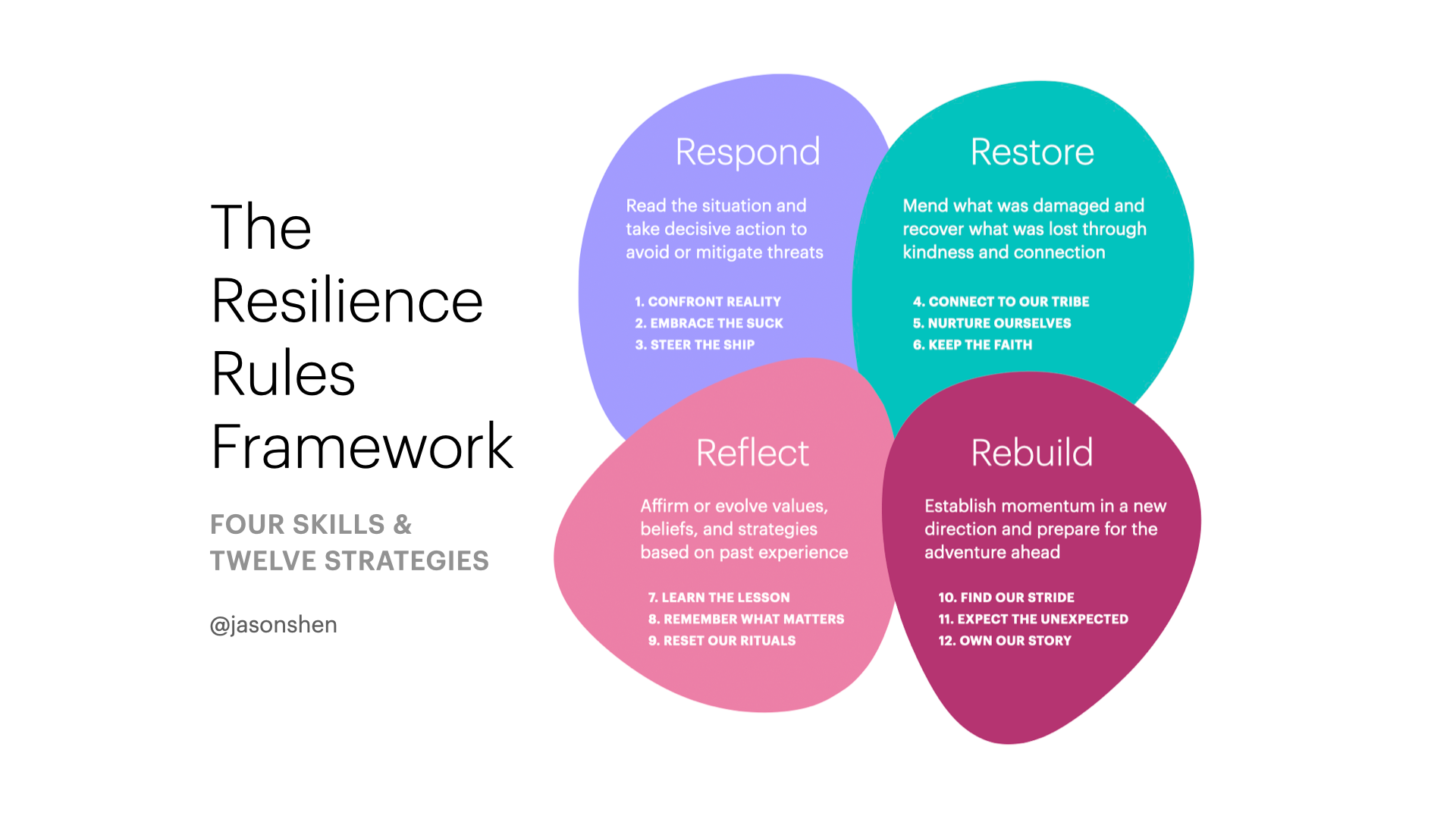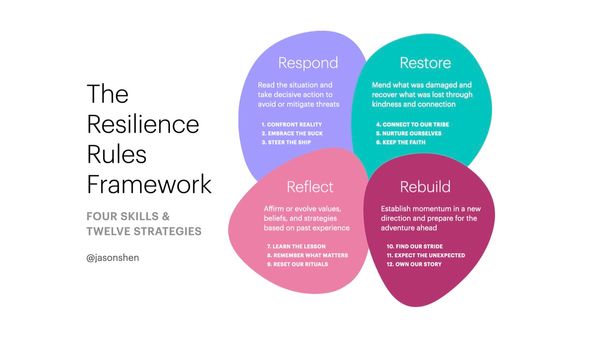This is the 55th edition of Cultivating Resilience, a weekly newsletter how we build, adapt, and lead in times of change.
5 editions ago I renamed this newsletter to Cultivating Resilience. The goal was to bring focus and a theme to what we talk about here.
Resilience is a wonderful topic because it can be tied almost anything. Resilience the ability to adapt successfully to adversity and change. We can talk about physical & athletic resilience, career resilience, financial resilience, and even climate resilience.
As a first-generation immigrant, a former elite athlete, and a serial entrepreneur, I’ve faced a lot of difficult situations and rapid change in my thirty-five years. And I’ve handled it pretty well all things considered. Over the last 18 months or so, I’ve been collating my thoughts about resilience into a framework that I wanted to share.
I call it the Resilience Rules framework and it will be the focus of this edition.
Like what you see? Why not bring someone to the party?
🖼 Visualizing the Framework

🧠 How to Adapt in the Face of Change
The goal of resilience is to produce strong outcomes in the face of adversity and change.
Resilience is a product of our skills of adaptation and how support our surrounding environment is. The bigger the change, the our skill and environment need to be to produce an acceptable outcome.
Focusing on skills is the most important thing we can do because our environment is only indirectly in our control. If we’re soccer players in the game of life, we can’t control the field, our teammates, our opponents, the crowd, the referees, etc. At least not very much. We can only control how we play our game, and try to influence those other factors.
There are four major skills of resilience, and they follow a rough order of operations (though there’s a lot of overlap)
The first skill is Respond
When we encounter danger or adversity, we can’t sit still. We have to read the situation and muster the courage to take decisive action and mitigate the damage.
The 3 strategies that help us respond are confront reality, embrace the suck, and steer the ship. We’ll talk about each of those in depth another time.
The second skill is Restore / Repair1
Withstanding hardship comes at a cost and healing does not just happen on its own. We have to take measures to mend what has been damaged and regain what has been lost through the power of kindness, relationships, and belief.
The 3 strategies that can help us restore / repair are connecting to our tribe, nurturing ourselves, and keeping the faith.
These two skills are what I might call static, or level 1 resilience. We do these things all the time, for changes big and small. And by responding and restoring, we can get back to some kind of normalcy. It might not be great, but it’s sufficient to get going.
The next two skills are practiced far less often in my experience. They’re harder to do but can help us go beyond normal or baseline, and actually grow and improve through adversity. If you’ve heard of post-traumatic growth, this is where a lot of that work takes place. I call these dynamic skills or level 2 resilience.
The third skill is to Reflect
Moments of adversity give us an opportunity to rethink how we see ourselves and the world. We have an opportunity to reconnect to our deepest values and consider new approaches in the light of this new understanding.
The strategies of reflection include learn the lesson, remember what matters, and reset our rituals.
The last skill is to Rebuild
Once we have reoriented ourselves, we can establish momentum and accelerate in a new direction, telling a new story about ourselves in the process and preparing for the adventure and new challenges that await.
The strategies of rebuilding include find your stride, expect the unexpected, and own your story.
Of course, there is no “end” when it comes to resilience because change is always a part of our lives. We are always dealing with different kinds of adversity and turmoil in different areas at any given time. But this framework is helpful for thinking about all kind of challenges: from having your home broken into, to getting reassigned to a new team at work, to handling a divorce.
👉 Build Resilience Through HIIT
I’m a big fan of high-intensity interval training. There’s research that it’s better at burning fat than moderate pace cardio and it also can help develop our ability to “embrace the suck”, one of the strategies within the Respond skillset. Because when you put yourself through hell voluntarily, other things don’t look as bad.
If you’re a beginner to this kind of training, here’s a protocol to try out. Of course you should always seek the consultation of a medical professional as I am not a doctor nor do I play one on TV.
- Begin with a 2 minute active warm up (e.g. jumping jacks or running in place)
- Choose an exercise: running, biking, jump rope, elliptical, mountain climbers, burpees
- Move at a slow / light pace for 30 seconds
- Move at a moderate pace for 20 seconds
- Move at a near maximal pace for 10 seconds
- Repeat five rounds to form one block
- Start with one block of five rounds, and as you get better, add additional blocks over time with 1-2 minutes breaks between
- Cool down with a 2-3 active stretch
And if you’re looking for more variety, you can find that in my list of bodyweight workouts, check out what I post on Twitter, or get a tough 30 mins workout with Nina Dobrev & Les Mills.
—
That’s it for me this week. Would love to hear how this piece landed for you and what other questions you have about resilience. I read every piece of reader feedback (even if I don’t respond to all of you).
-Jason
👨🏻💻 About Me
Jason Shen is a three-time startup founder turned Facebook PM. He’s written about productivity, resilience, and the future of work in publications like Fast Company, Vox, TechCrunch and spoken at events at TED, Google, and The White House. Jason lives in Brooklyn with his wife Amanda, an award-winning artist, along with two kettlebells, and many piles of books.
I’m still working out the wording - LMK if you like one over the other. Repair is more concrete, but implies that something is “broken”, which I don’t love. Restore is more open - like restoring a painting or an old building. But I get it may feel more abstract.
